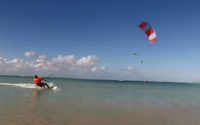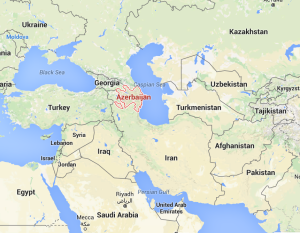Baku 20 years later – a photo essay
By Tom Mueller
I returned to Azerbaijan recently after a bit more than 20 years away, and was excited to see how the country had changed as its fledgling oil industry has matured.
I spent many weeks in Baku, the capital city, in 1993-95 as part of the energy industry’s entry to Azerbaijan following the breakup of the former Soviet Union, of which Azerbaijan was a part. At the time, I was working for Amoco Corp. and was part of the team working to secure a contract to help develop the country’s oil and gas resources.
For those who are not familiar with the country, below is a map showing the location – in a region full of modern day political drama. Yet Azerbaijan seems to be balancing competing political, social and commercial interests to maintain a stable balance in a sometimes unstable region.
The change in the past 20 years is just remarkable. Baku has been transformed from what I remember as a somewhat bleak, Soviet-era city of block structures to a modern, cosmopolitan city with cafes, shops, upscale shopping districts that are foot-traffic only, and many restaurants. Crosswalks across major roads and highways have now been tunneled beneath those roads, allowing easy movement around the city without the challenge of dodging fast-moving car and truck traffic.
Many other changes have been made over the years since I last visited, changes such as construction of the Baku Eye – a 60-meter (200 foot) tall Ferris wheel similar to the Eye of London – skyscrapers lighted at night, and event facilities and museums, all of which are helping create a very modern capital city.
I shot a lot of photographs during my time in Azerbaijan 20-plus years ago, and I attempted to recreate those same photos when I returned in 2015. This post focuses on the before and after photographs to help visually illustrate the changes that have occurred, at least as I saw them through my camera lens.
In 1993, the Old Intourist Hotel, served as our company office and our accommodation as well. There just were not many options for hotel space then. The hotel was an aged structure of parquet wood floors, was dimly lit and often smelled of solvents and mineral spirits used to clean the carpets and hallway runners. My, how times have changed in the hotel industry in Baku!
The city now boasts more than 150 hotels at all price points. You can find five star luxury hotels such as the J.W. Marriott Absheron Hotel, with all the accouterments you’d expect from a luxury hotel; and you’ll also find many hotels, such as the Premier Hotel, at more economic price points. Even the Old Intourist Hotel has been updated to remain competitive in the local market.
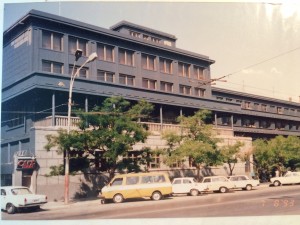
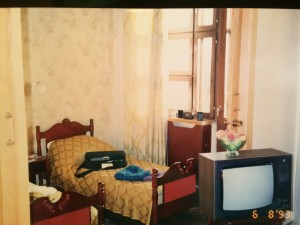
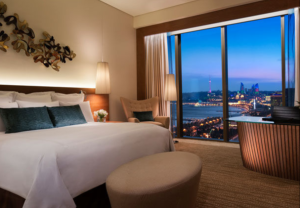
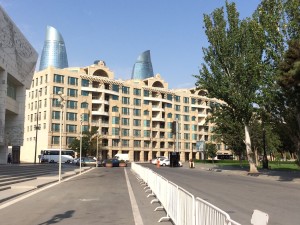
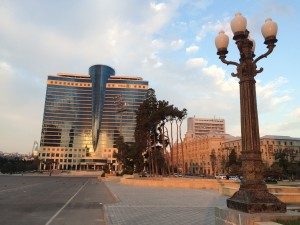
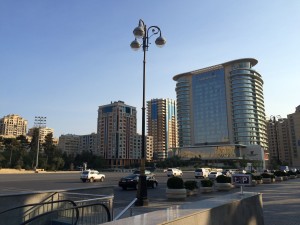
One of Baku’s most treasured historical assets is its long-stretching harbor front area, known as The Boulevard and also hosting Bulvar Park. The area has always been a getaway place for couples and others seeking a quiet walk or some exercise, but it had fallen into disrepair during the 1980s. The transformation along this waterfront space since I last visited has been amazing, as the photos below will show. The area has been transformed into a friendly, well-designed public space frequented by locals, visitors, businessmen in suits – and young couples seeking some private time together.
There you will find restaurants and cafes, a movie house, water fountains, a replica of a Venice water canal system, complete with gondolas, and a generally welcoming atmosphere. The effort to create a world-class public space is quite evident, and I thoroughly enjoyed my time spent walking and sightseeing in this area.
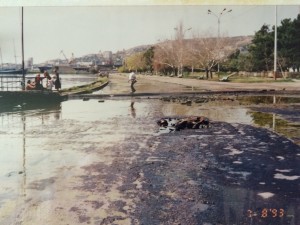
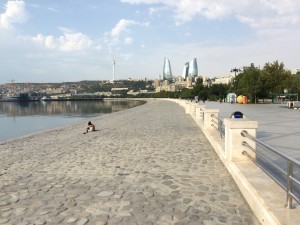
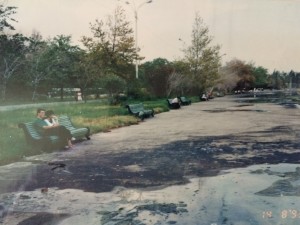
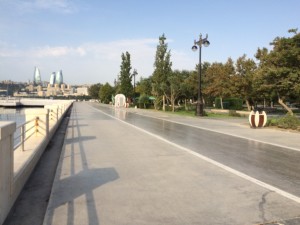
The next photo I sought to update is one showing the main government ministry building in Baku, adjacent to Bulvar Park and the water front. This structure houses many of the government departments. The change here from 20 years ago was quite dramatic as well: the exterior has been cleaned and repaired; a huge underground parking garage has been added, and underground crosswalks now carry pedestrians between the building and the restaurants and cafes along the water front.
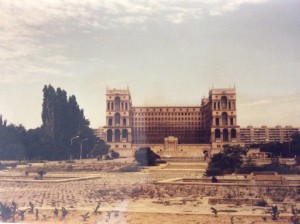

Looking out over the city and waterfront area also give you a good sense for the transition that has occurred in the city. The pictures below show the changes in the city skyline and harbor areas.
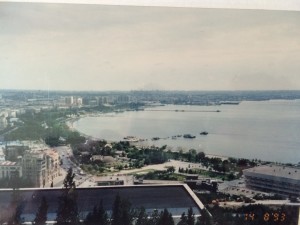
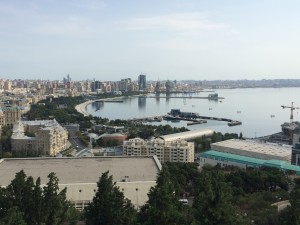
The city has long hosted a funicular that moves passengers from Bulvar Park, near the new carpet museum, up to scenic overlook areas and Heroes Cemetery or Martyr’s Lane. The tram system and passenger cars have been updated several times since the photo below was shot in 1993.


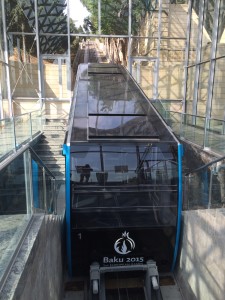
Back in the early 90s, there was much public use of the water front space, including entertainment activities such as riding a mini train on tracks, and playing pool on the many outdoor pool tables that were set up along the walking paths at that time. As mentioned, the area has been completely transformed and updated.
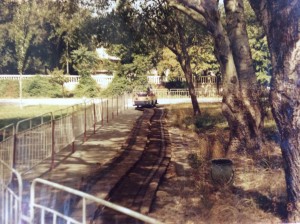
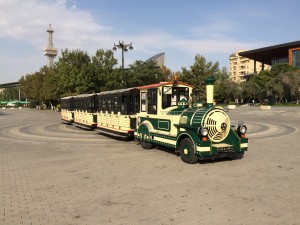
And finally, a look at one pier in the harbor and how that has been transformed. In the first picture below, several sailboats and other vessels can be seen docked to an invisible pier. At that time, the level of the Caspian Sea was rising – inexplicably – and had put this pier under water. The photo comparison shows clearly how the area has been updated and improved.
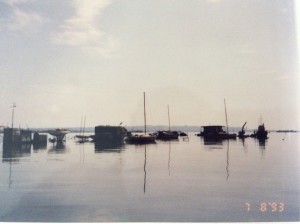
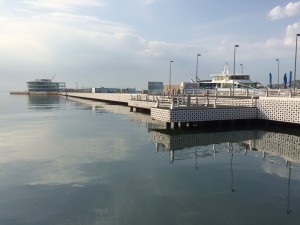
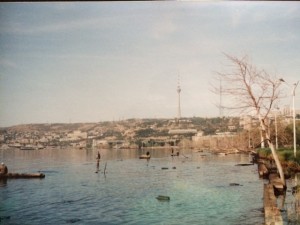
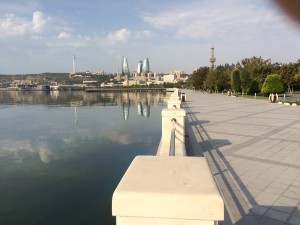
The Zoroastrian religion of fire worshipers has historically been a presence throughout the region, probably owing to the plentiful supply of oil and gas seeps that provided fuel for fires from ancient times. So the flame is a long-standing symbol in the region. The city’s new sky-scraping Flame Towers are a modern depiction of the ancient flame, especially when illuminated at night, as shown below.
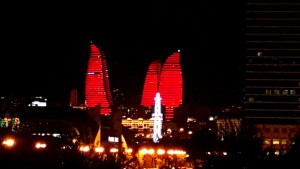
It was a rare opportunity for me to be able to return to Azerbaijan after so many years away, and to be able to update my original photos. Azerbaijan will be a country to watch in the coming years, and is certainly an interesting place to visit if you get the opportunity.
Related Posts

Floating Christmas presents – behind the scenes of a holiday boat parade
